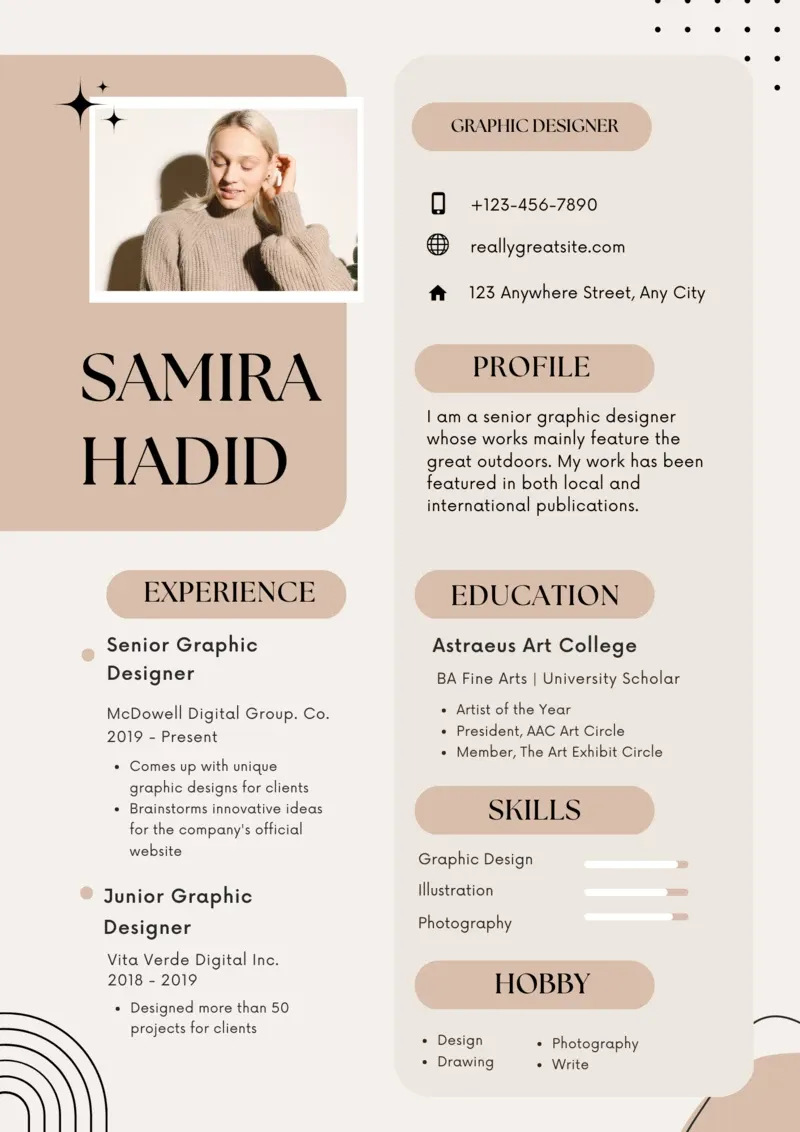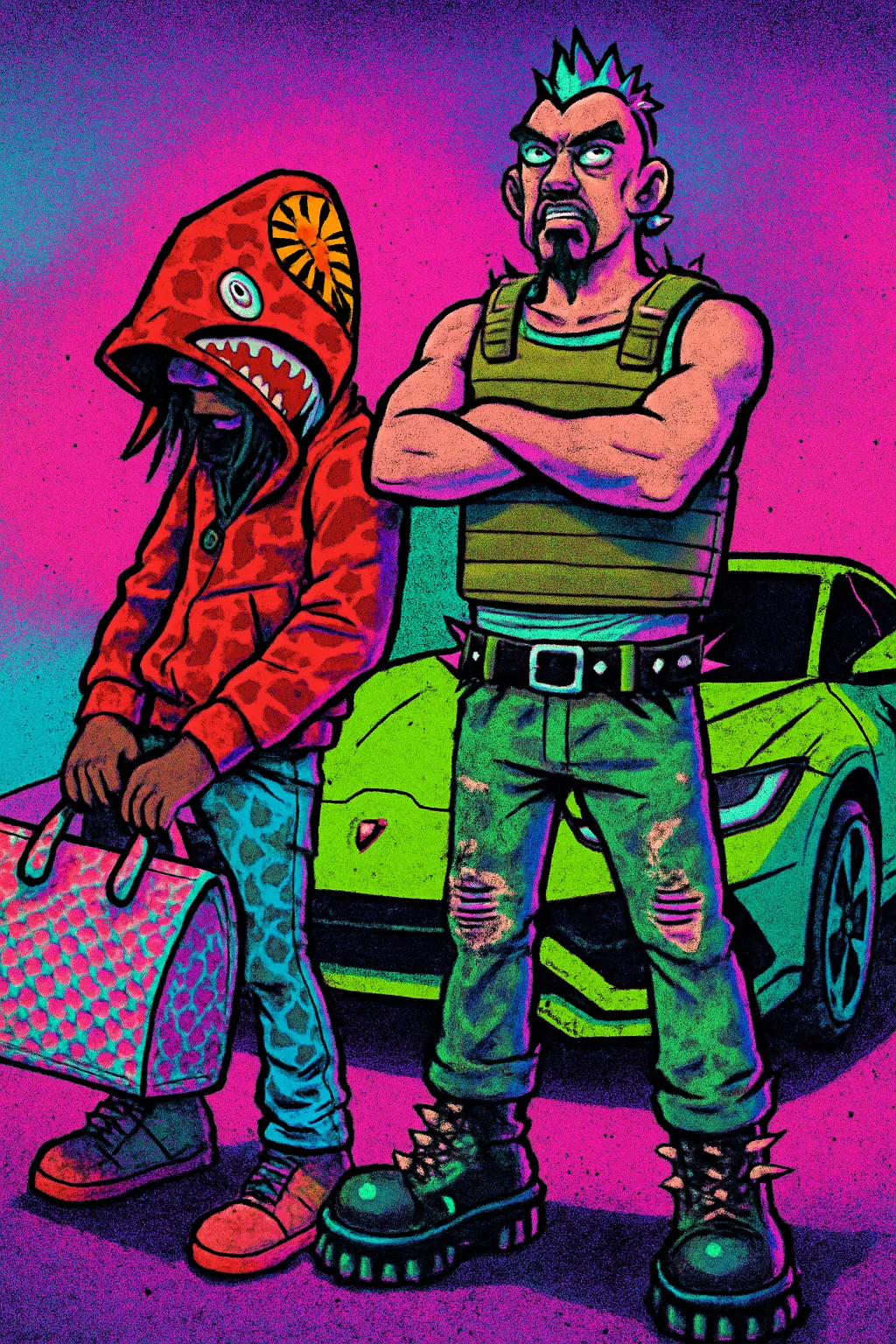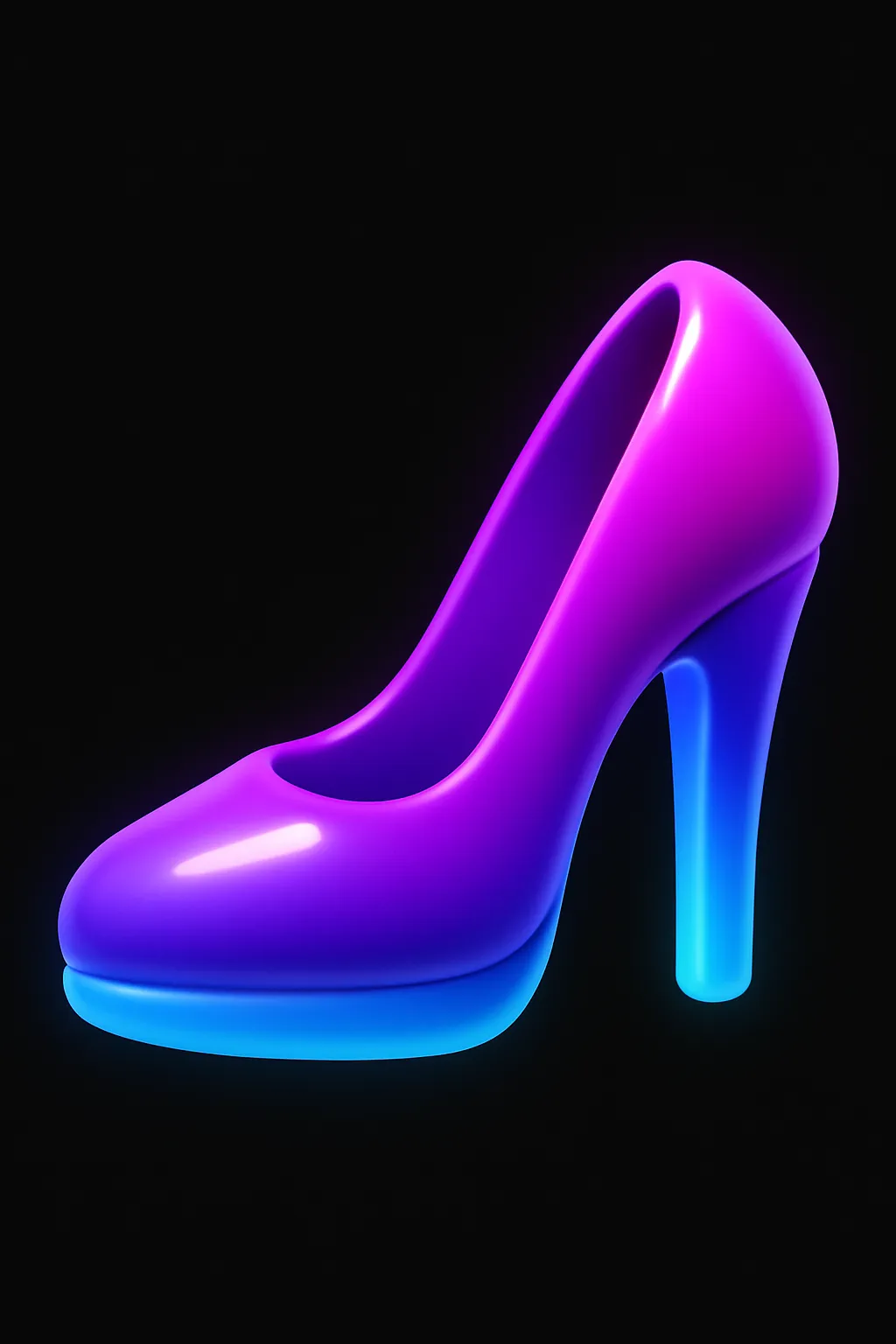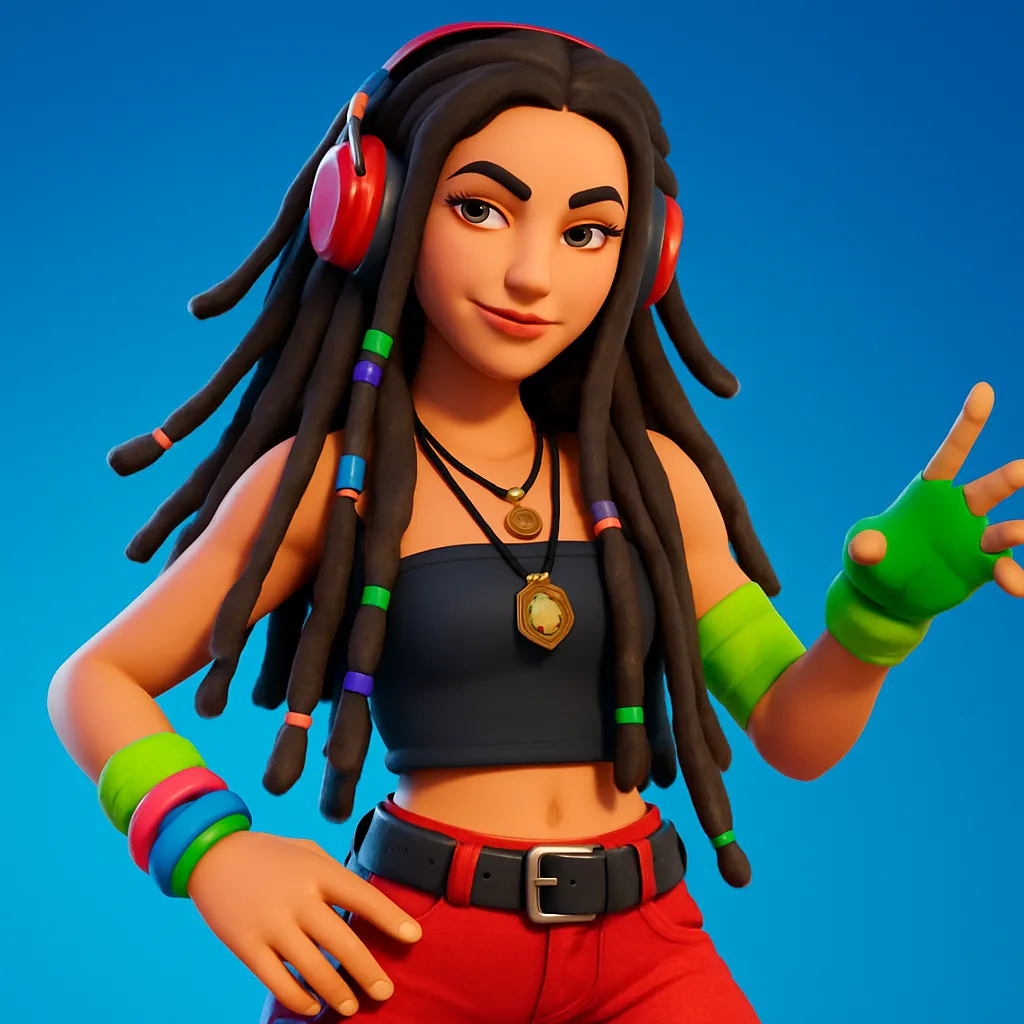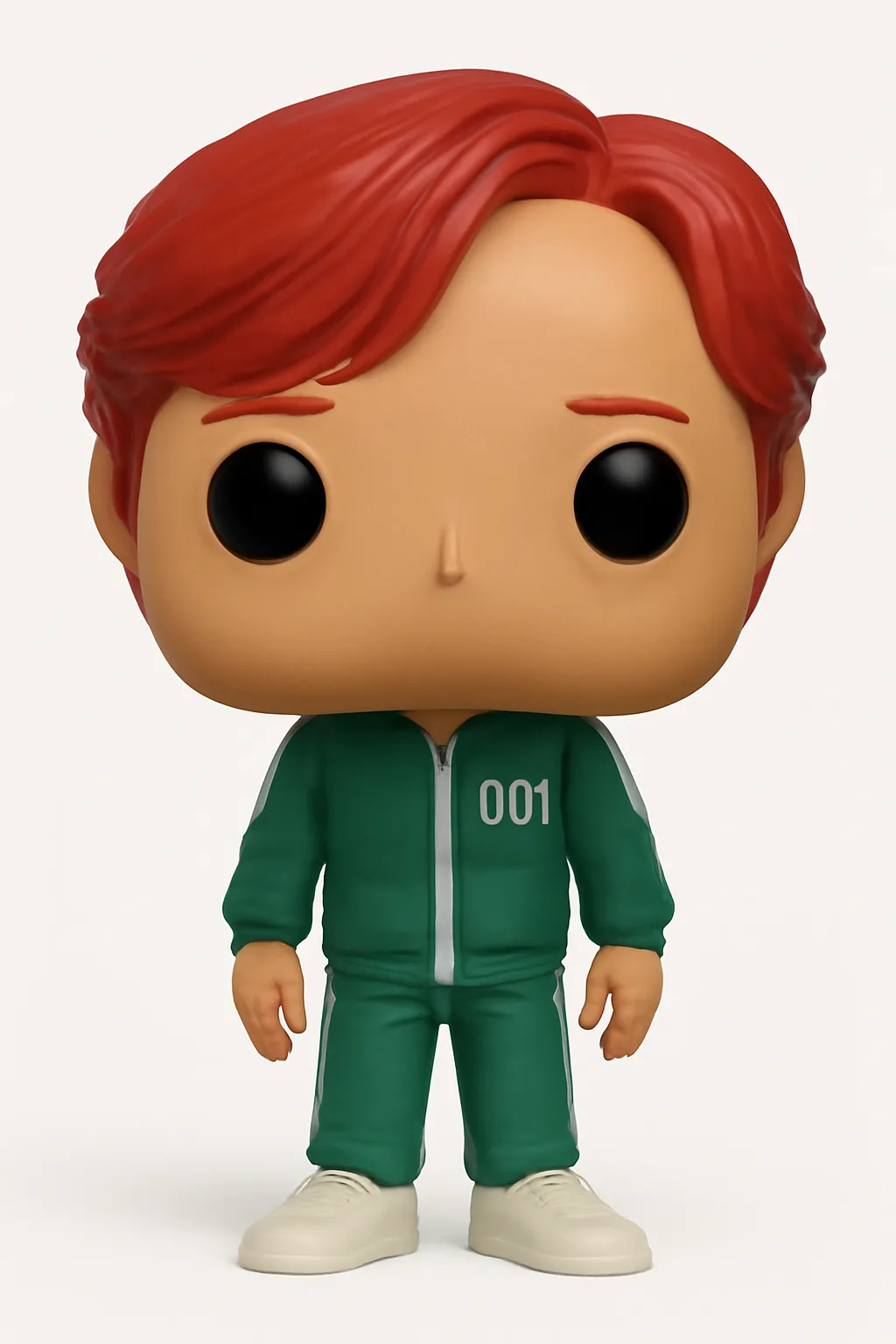Here is a revised and improved version of your CV targeting a Senior Graphic Designer role. I have corrected grammar, improved clarity and professionalism, removed redundancy, and ensured consistent formatting. I also made your achievements more results-oriented where possible:
Samira Hadid
Senior Graphic Designer
+123-456-7890 | reallygreatsite.com | 123 Anywhere Street, Any City
Profile
Senior Graphic Designer specializing in projects inspired by the great outdoors. Proven track record of delivering unique, innovative designs that have been featured in both local and international publications. Adept at collaborating with clients and internal teams to create compelling visuals aligned with brand objectives.
Experience
Senior Graphic Designer
McDowell Digital Group Co. | 2019 – Present
- Developed distinctive graphic designs tailored to client needs, enhancing brand identity and engagement
- Led brainstorming sessions to generate creative concepts for the company’s official website, increasing user interaction
- Collaborated cross-functionally to ensure timely project delivery and adherence to quality standards
Junior Graphic Designer
Vita Verde Digital Inc. | 2018 – 2019
- Designed and delivered over 50 client projects, consistently meeting deadlines and client requirements
- Supported senior designers by creating drafts, mockups, and revisions, contributing to overall team success
Education
Astraeus Art College
BA Fine Arts | University Scholar
- Artist of the Year
- President, AAC Art Circle
- Member, The Art Exhibit Circle
Skills
- Graphic Design (Advanced)
- Illustration (Intermediate)
- Photography (Basic)
Hobbies
- Design
- Drawing
- Photography
- Writing
Suggestions:
- Consider adding a "Tools & Software" section listing programs like Adobe Creative Suite, Sketch, Figma, etc., which are crucial for a senior graphic designer.
- Include any certifications (e.g., Adobe Certified Expert) or relevant courses if applicable.
- Quantify further wherever possible, e.g., "Increased client engagement by X% through redesigned visuals."
- Emphasize leadership or mentorship roles you've had to strengthen your senior-level candidacy.
Let me know if you want me to help you draft those additions!
Review and revise your application (CV)
If you are confused and wondering if your job application is good or if there are any mistakes, try this prompt, it will tell you what you need to edit appropriately.
Prompt body
Reference images
Similar prompts
The Anxiety of Generation Z: Navigating a Complex Landscape
In recent years, the anxiety experienced by Generation Z—those born roughly between the mid-1990s and early 2010s—has become a subject of intense scrutiny in psychological, sociological, and educational discourse. Unlike previous generations, Gen Z grapples with unique stressors amplified by rapid technological advancement, socio-political instability, and an unprecedented awareness of global issues. This essay explores the multifaceted nature of anxiety within Generation Z, arguing that while technological connectivity has enabled greater access to information and social platforms, it simultaneously exacerbates feelings of isolation, pressure, and uncertainty. Understanding the sources and characteristics of Gen Z anxiety is crucial for developing effective support systems and interventions tailored to their experience.
Central to the anxiety of Gen Z is the pervasive influence of digital technology and social media, which has reshaped social interactions, self-perception, and emotional well-being. Studies have shown that excessive social media use correlates with increased anxiety and depressive symptoms, as individuals are often exposed to idealized portrayals of peers’ lives, leading to negative self-comparison and diminished self-esteem (Twenge et al., 2018). Furthermore, the constant online connectivity blurs the boundaries between work, education, and leisure, creating a relentless environment where the pressure to perform and present a curated identity persists around the clock. This digital omnipresence fosters a paradoxical state of hyperconnectivity coupled with social isolation, contributing significantly to anxiety disorders among Gen Z.
Beyond technological factors, Gen Z faces distinct socio-economic and global challenges that intensify their anxiety. Many young people in this cohort entered adulthood during times marked by economic instability, such as the aftermath of the 2008 financial crisis and the COVID-19 pandemic's disruptions. Job insecurity and student debt compound anxieties about future prospects and financial independence (American Psychological Association, 2020). Moreover, Gen Z is acutely aware of existential threats like climate change, political polarization, and social justice issues, which generate collective anxiety about the state of the world. This heightened consciousness fosters a form of “eco-anxiety” and political stress uncommon in previous generations, as young people feel an urgent responsibility to address complex global problems often beyond their immediate control.
Educational environments and societal expectations further intensify anxiety among Gen Z. The pressure to excel academically, secure prestigious employment, and maintain a robust extracurricular profile has escalated in an increasingly competitive global landscape. According to the Pew Research Center (2019), Gen Z reports higher levels of stress related to educational achievement than Millennials or Gen X at the same age. Additionally, the stigma surrounding mental health has gradually diminished, prompting more young people to acknowledge and report their anxiety. While this openness is a positive development, it also highlights the scale of the mental health crisis facing Gen Z and the need for systemic change in how institutions support psychological well-being.
In conclusion, the anxiety experienced by Generation Z is a complex phenomenon rooted in the interplay of technological, socio-economic, and cultural factors. While digital connectivity offers unparalleled opportunities for communication and learning, it simultaneously fuels insecurity and isolation. Coupled with economic pressures and acute awareness of global challenges, these conditions create a perfect storm for pervasive anxiety. Addressing this issue requires a comprehensive approach that includes mental health education, systemic reforms in education and employment sectors, and responsible technology use. By recognizing and responding to the unique stressors that shape Gen Z’s experience, society can foster a healthier environment that empowers this generation to thrive despite the uncertainties they face.
References
American Psychological Association. (2020). Stress in America 2020: A National Mental Health Crisis. https://www.apa.org/news/press/releases/stress/2020/report
Pew Research Center. (2019). On the Cusp of Adulthood and Facing an Uncertain Future: What We Know About Gen Z So Far. https://www.pewresearch.org/social-trends/2019/05/14/on-the-cusp-of-adulthood-and-facing-an-uncertain-future-what-we-know-about-gen-z-so-far/
Twenge, J. M., Martin, G. N., & Spitzberg, B. H. (2018). Trends in U.S. Adolescents’ Media Use, 1976–2016: The Rise of Digital Media, the Decline of TV, and the (Near) Demise of Print. Psychology of Popular Media Culture, 8(4), 329–345. https://doi.org/10.1037/ppm0000186

Write an Essay 📝
Great that you want to validate your mental wellness app idea before investing heavily! Validating early with real potential users can save time, money, and ensure product-market fit. Here’s a practical step-by-step guide tailored for a mobile app-based self-care business using low-cost methods:
Step 1: Define Your Hypotheses and Target Audience
- Identify Core Problem: Clearly state the problem your app solves.
- Define User Persona: Who exactly is your app for? (age, gender, lifestyle, mental wellness goals)
- Value Proposition: What unique benefit does your app offer compared to existing solutions?
Example: “Young professionals aged 25-35 struggling to manage daily stress with limited time, who want quick and effective self-care exercises.”
Step 2: Conduct Desk Research
- Competitor Analysis: Study existing mental wellness/self-care apps (e.g., Headspace, Calm, Sanity & Self).
- Market Validation: Look for market reports, trends, and surveys highlighting user needs in mental wellness.
- Identify Gaps: What are competitors missing that your solution will provide?
Step 3: Build a Simple Landing Page (Pre-Launch or MVP Site)
- Use tools like Carrd or Unbounce to create a single-page website.
- Clearly describe the app’s benefits and features.
- Add a call-to-action (CTA) to collect email addresses of interested users ("Get Early Access," "Join Waitlist").
Purpose: Test interest and gather contact info for early adopters without building the app.
Step 4: Run Targeted Ads and Social Media Tests
- Use Facebook/Instagram or TikTok ads targeted at your user personas with a compelling ad copy and link to your landing page.
- Alternatively, post in relevant mental health and self-care communities on Reddit, Facebook Groups, or LinkedIn.
- Measure click-through rates, sign-ups, and engagement to gauge demand.
Cost tip: Start with a small daily budget ($5-$10) to test waters.
Step 5: Conduct Qualitative Customer Interviews
- Reach out to your email subscribers or community members who signed up.
- Use Zoom or phone calls to interview 5-10 potential users. Focus on:
- Their current coping strategies for mental wellness
- Challenges they face with current solutions/apps
- Feedback on your app concept and willingness to pay
Step 6: Create a Concierge MVP or Wizard of Oz Prototype
- Concierge MVP: Manually deliver core self-care activities you intend to automate, interacting personally with a few users.
- Wizard of Oz: Build a very simple app interface or prototype that looks functional but is manually operated behind the scenes.
Purpose: Validate user engagement and see if your idea really helps users before automating with full development.
Step 7: Run a Minimal Viable Product (MVP) or Prototype Test
- Use no-code tools like Bubble, Adalo, or Glide to build a clickable app prototype or a barebones MVP with core features.
- Deploy to a small user group (from your email list or community).
- Collect quantitative and qualitative feedback on usability, features, and perceived value.
Step 8: Validate Willingness to Pay
- Test pricing and monetization models through surveys or by offering premium early access plans/memberships.
- See if users are willing to pay upfront, subscribe monthly, or prefer freemium options.
Step 9: Analyze and Iterate
- Review all collected data: signup conversion rates, interview insights, prototype usage stats, and payment interest.
- Identify if the demand and user feedback support moving forward.
- Refine the value proposition and features before full build.
Bonus Tips:
- Be Transparent and Ethical: Because it’s mental wellness, ensure you’re clear about the app’s role (not a replacement for professional help) and handle user data sensitively.
- Focus on Core Value: Don’t build everything at once; concentrate on one or two key features that solve a painful and specific problem.
- Build a Community Early: Leverage social media groups or forums for organic growth and validation.
If you want, I can help you draft landing page copy, ad ideas, interview questions, or prototype plans next!

